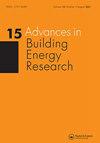Estimating energy savings of ultra-high-performance fibre-reinforced concrete facade panels at the early design stage of buildings using gradient boosting machines
IF 2.5
Q2 CONSTRUCTION & BUILDING TECHNOLOGY
引用次数: 4
Abstract
ABSTRACT The selection of an energy-efficient building facade system, as one of the most important early-stage design decisions, plays a crucial role in reducing building energy use by controlling heat transmission between outdoor and indoor environments. This paper aims to evaluate the feasibility and applicability of gradient boosting machines in estimating the energy savings of different facade alternatives in the early-stage design of building facades. The energy performance of two competing facade systems was estimated for different scenarios using building energy simulations (i.e. EnergyPlusTM ). Three gradient boosting machines were developed based on the data collected from the simulation of thirteen building types in fifteen different locations (i.e. 195 scenarios). The prediction performance of gradient boosting models was compared with the building energy simulation results of two new building models that were not used in the database development phase to validate the models. Moreover, the prediction power of the trained gradient boosting models was compared with three common prediction models (i.e. Artificial Neural Networks, Random Forest, and Generalized Linear Regression) based on several performance metrics. The results showed the superiority of gradient boosting machines over other models in estimating total site energy savings, heating energy savings, and buildings’ cooling energy savings.在建筑设计初期使用梯度提升机的超高性能纤维增强混凝土立面板的节能估算
摘要节能建筑外立面系统的选择是早期最重要的设计决策之一,通过控制室外和室内环境之间的热传递,在减少建筑能耗方面发挥着至关重要的作用。本文旨在评估梯度提升机在建筑立面早期设计中评估不同立面方案节能的可行性和适用性。使用建筑能源模拟(即EnergyPlusTM)对不同场景下两个竞争立面系统的能源性能进行了估计。基于对15个不同地点(即195个场景)的13种建筑类型的模拟所收集的数据,开发了三台梯度提升机。将梯度提升模型的预测性能与数据库开发阶段未使用的两个新建筑模型的建筑能量模拟结果进行了比较,以验证模型。此外,基于几个性能指标,将训练的梯度增强模型的预测能力与三种常见的预测模型(即人工神经网络、随机森林和广义线性回归)进行了比较。结果表明,与其他模型相比,梯度升压机在估算现场总节能、供暖节能和建筑物制冷节能方面具有优势。
本文章由计算机程序翻译,如有差异,请以英文原文为准。
求助全文
约1分钟内获得全文
求助全文
来源期刊

Advances in Building Energy Research
CONSTRUCTION & BUILDING TECHNOLOGY-
CiteScore
4.80
自引率
5.00%
发文量
11
 求助内容:
求助内容: 应助结果提醒方式:
应助结果提醒方式:


